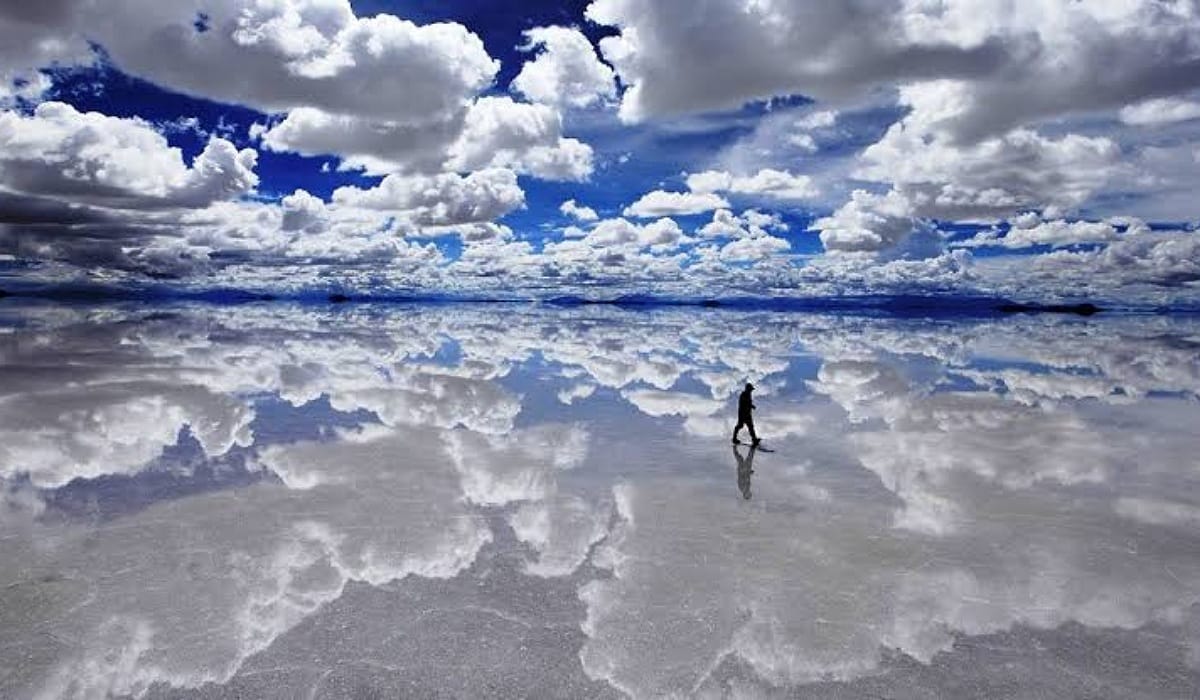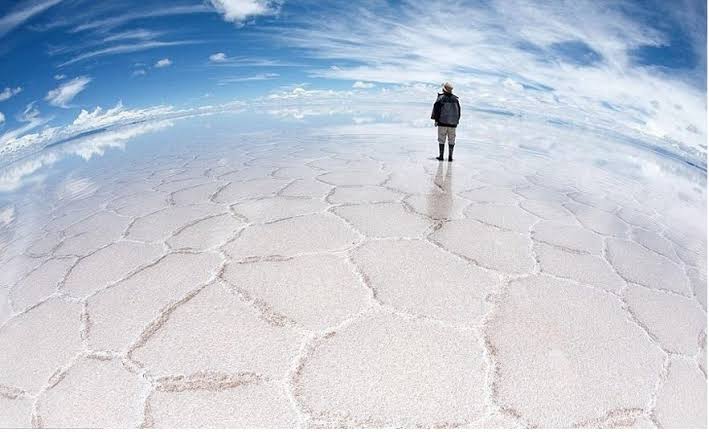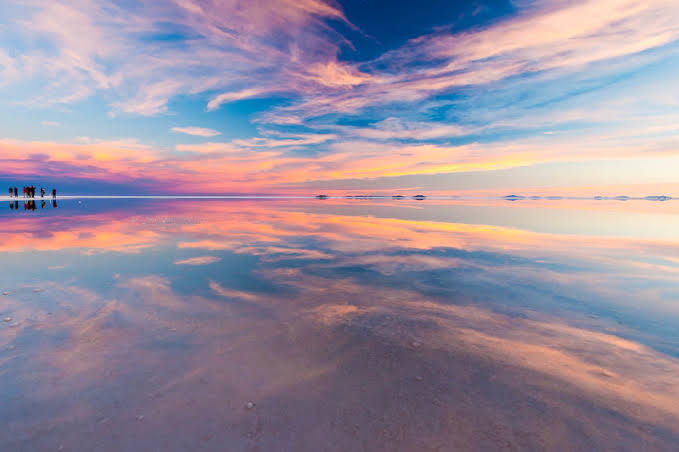White Magic in Salar de Uyuni: A Tour of the Salt Desert

Salar de Uyuni is one of the most remarkable natural wonders in Bolivia and the world, and is considered the largest salt flat in the world, covering an area of approximately 10,582 square kilometers in the southwestern region of Bolivia. Salar de Uyuni is not only a magnificent natural landmark, but also a unique tourist destination that attracts visitors from all over the world thanks to its breathtaking beauty and unique views, especially when it turns into a mirror reflecting the sky during certain seasons.
Location and geographical importance of Salar de Uyuni:
Salar de Uyuni is located in the high Altiplano region of the Andes, at an elevation of approximately 3,656 meters above sea level. This salt flat was formed thousands of years ago when the area was part of a huge lake known as Lake Minchin. Over time, the lake dried up, leaving behind this vast expanse of salt that is considered one of the largest salt reserves in the world, with an estimated 10 billion tons of salt reserves.
The unique natural phenomenon of Salar de Uyuni:
What makes Salar de Uyuni so special is that its surface transforms into a huge mirror that reflects the sky in a magical way, especially during the rainy season, which usually runs from January to March. This reflection is caused by a thin layer of water covering the salt, creating a stunning visual effect that makes visitors feel as if they are walking on water. Known as the “mirror of the sky,” this sight is considered one of the most amazing sights to be seen on Earth, making Salar de Uyuni a popular photo destination and a unique tourism experience.

History and geological formation of the Salar de Uyuni:
The Salar de Uyuni is formed from the accumulation of salts and sediments left behind by vast ancient lakes. This area was once a large freshwater lake that dried up over time due to climate and geological changes. When the lake dried up, it left behind vast quantities of salts and minerals, including lithium, potassium, and magnesium. This salt flat is an important source of mineral wealth, as Bolivia has one of the largest reserves of lithium in the world, a key component in the manufacture of lithium batteries used in electronic devices and electric cars.
The ecosystem in Salar de Uyuni:
Although the Salar de Uyuni appears to be a cold and arid environment, it is home to certain species that have adapted to live in these harsh conditions. One of the most famous animals that inhabit the area is the pink flamingo, which migrates in large numbers during the breeding season. In addition to flamingos, other species of birds can be found, such as ducks and geese, as well as small plant species that live on the edges.
Tourism in Salar de Uyuni:
Tourism is an important source of income for Bolivia, and Salar de Uyuni is one of its most important tourist destinations. Tourists come to this area to enjoy the stunning natural beauty and wonderful views, and to experience the famous mirror effect. There are many tours available in the area, where visitors can take a tour of the salt flats and visit nearby islands such as Inca Huatia Island, famous for its giant cacti, which can reach several meters in height.
Salar de Uyuni offers a unique experience for photography enthusiasts thanks to its changing landscapes with the seasons, with colours and views varying from the calm reflections of the sky in the rainy season to the pure white salt formations in the dry season.
Optical phenomena and photographic experience of Salar de Uyuni:
Salar de Uyuni is a favorite spot for nature photographers and artists, due to the optical phenomena produced by the terrain of the area. During the rainy season, the reflection creates an optical effect that reflects the sky in a clear and precise way, giving the photos a magical quality that is difficult to replicate in other places. During the dry season, hexagonal cracks appear on the surface of the salt, adding a geometric beauty to the landscape. Many photographers use this geometric effect with natural lighting to produce stunning artistic images.

Environmental challenges of Salar de Uyuni and the balance between tourism and nature conservation:
Despite the popularity of Salar de Uyuni as a tourist destination, intensive tourism and mineral extraction pose environmental challenges that threaten the unique ecosystem of the area. The large increase in the number of tourists leads to increased waste and changes in the ecosystem, requiring authorities to take measures to protect the area from environmental pollution. The Bolivian government seeks to implement policies aimed at reducing the impact of human activities, with an emphasis on developing sustainable tourism that preserves the natural beauty and protects the natural resources of Salar de Uyuni .
Lithium Resources Investment in Salar de Uyuni:
Lithium is one of the main economic resources of the Salar de Uyuni , as the region contains vast quantities of this vital mineral used in the manufacture of lithium batteries that power many electronic devices and electric cars. The Bolivian government aims to exploit lithium resources in a way that contributes to the country’s economic development, while ensuring environmental protection. Plans have been developed to extract lithium efficiently and responsibly, but this requires huge investments and advanced technology to avoid environmental damage.
Salar de Uyuni visiting hours:
The experience of visiting the Salar de Uyuni varies depending on the time of year. During the dry season (May to October), a hard surface of salt forms, allowing visitors to walk and ride vehicles with ease. During the rainy season (January to March), water covers the surface, transforming the area into a huge mirror reflecting the sky. Any season is a good time to visit, but choosing the right time depends on the type of experience you want to have.
How to get to Salar de Uyuni?
The Salar de Uyuni is accessible via the city of Uyuni, which is the main gateway to the region. Domestic flights to Uyuni are available from the capital city of La Paz, as well as bus services from major cities. Once in Uyuni, visitors can join organized tours that include visits to the main sites of the salt flat and nearby islands. Tours usually include transportation, accommodation, and meals, making it easy to experience tourism in this remote location.
Cultural Experience in Salar de Uyuni:
In addition to the beauty of the Salar de Uyuni , the Uyuni region is distinguished by its unique culture and traditional heritage. Many of the region’s inhabitants live in simple conditions, relying heavily on tourism, fishing, and agriculture. While visiting the region, visitors can sample local cuisine and learn about handicrafts that reflect Bolivian heritage, such as weaving and textile making. They can also interact with the locals, who offer visitors an in-depth look into their culture and traditions.
Suggested for you: The Pyramids of Giza
Conclusion
Bolivia’s Salar de Uyuni is more than just a salt flat. It is a fascinating combination of natural beauty and biodiversity, as well as an important source of mineral wealth that supports the local economy. The famous mirror landscapes make this place an unforgettable destination and a unique experience for nature lovers and tourists. The environmental challenges and lithium investment make Salar de Uyuni an example of the need to balance development with environmental protection.


Comments